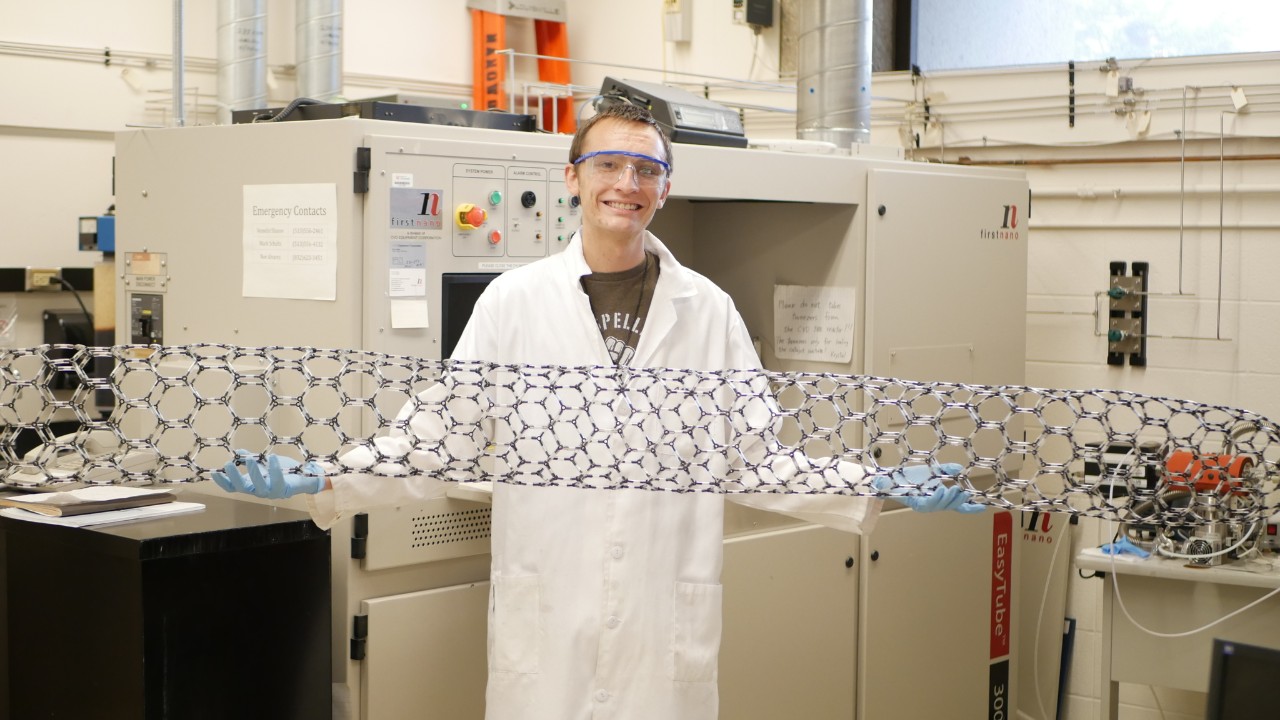
UC student finds passion for research in Nanoworld Lab
Chemical engineering student explores carbon-based energy storage devices

UC chemical engineering student Matthew Nichols works with graphene catalysts in the UC Nanoworld Lab. Photo/Corrie Stookey/CEAS Marketing.
When you send equipment up into space, it has to generate energy by itself. Typically, scientists and engineers rely on lithium-ion batteries to provide a long-lasting charge. However, these kinds of batteries have their limitations – they’re bulky, heavy and can easily overheat.
Researchers at the University of Cincinnati’s Nanoworld Laboratories have two major contracts – with NASA and the U.S. Department of Defense – to find a more efficient, longer-lasting energy storage device.
“[NASA and the Department of Defense] want the most energy storage for the lowest weight,” says chemical engineering student Matthew Nichols, one of the undergraduate research assistants in Nanoworld. “If you’re shooting something into space, every ounce matters.”
Nichols has spent three of his cooperative education (co-op) rotations working in Nanoworld under his mentor, UC professor of chemical engineering and co-director of Nanoworld Vesselin Shanov, PhD.
Nanoworld is focused on two major carbon-based materials that could potentially replace lithium-ion batteries in space: graphene and carbon nanotubes. Graphene is a flat sheet of hexagonal carbon atoms that can be transformed into a 3D structure combined with carbon nanotubes using a process called chemical vapor deposition. This hybrid of graphene and carbon nanotubes is lightweight, flexible and efficient. This hybrid is was what Nichols is synthesizing and testing.
Nanoworld has two chemical vapor deposition reactors, and Nichols operates both of them. His primary responsibility is to find a catalyst that can synthesize the best graphene to use for energy storage.
The standard catalyst used to synthesize graphene, explains Nichols, is nickel foil. This method, however, has its downsides: first, the pure nickel required in the process is expensive; second, the process only produces a few layers of graphene.

Nichols runs a casting knife across the surface of a graphene catalyst slurry. Photo/Corrie Stookey/CEAS Marketing.
Instead, Nichols can use a different catalyst like nickel powder, yielding graphene when running it through chemical vapor deposition in the presence of hydrocarbons. This produces a stronger, more versatile 3D material that is also more affordable, a key feature for full-scale implementation. Nichols is investigating various catalysts, including varieties of nickel powders and polymer binders to determine which one best suits the needs of the lab.
Ultimately, the end goal is to create a nanocarbon-based 3D structure that is lightweight, flexible and, in some cases, fiber based (meaning, for example, it can be woven into the actual fibers of an astronaut’s suit, rather than attached to gear like a backpack).
Ideally, these new 3D hybrid materials would be much lighter than the conventional lithium-ion batteries, which saves expensive rocket fuel.
This is Nichols’ first independent project. He hopes to draft a paper on the research and eventually submit it for publication. After that, he’s still undecided on what to do long term, but he does see this research as a potential jumping-off point for graduate school. He credits his mentor, Shanov, for lighting this passion for research.
“[Shanov] always expresses gratitude for things that I do, encourages me and gives me advice,” says Nichols. “Having him offer this opportunity to me was great.”
UC and Nanoworld have allowed Nichols to explore his passion for chemical engineering while developing a new passion for research and development in an innovative setting.
“Nobody has done what we’re doing right now,” says Nichols. “That’s what’s really exciting about all of this.”
Featured image at top: Matthew Nichols holding a lifesize replica of a carbon nanotube. Photo/Corrie Stookey/CEAS Marketing.
Find your path
Interested in encouraging others as you find your path to academic success? If so, apply to UC as an undergrad or graduate inspirational Bearcat. As part of UC's Next Lives Here strategic direction, UC's students makes positive and real-world impact.
Related Stories
UC biochemistry student explores world of taste
January 5, 2026
A University of Cincinnati biochemistry student changed her career trajectory after being inspired by internships with a European Fortune 500 company.
Engineering professors studying how co-op impacts student journey
January 5, 2026
Cedrick Kwuimy, associate professor educator in the Department of Engineering and Computing Education at the University of Cincinnati College of Engineering and Applied Science is studying how a student’s first co-op experience impacts the remainder of their journey as an engineering student, and how educators can better prepare them for these experiences. Kwuimy and his collaborators have received a three-year grant from the National Science Foundation (NSF) to support this research.
Two UC-backed startups score $200K each from state
December 23, 2025
Innovative startup ventures TapIn and Saturn Sports rose from the UC Venture Lab to receive $200,000 each in funding through Ohio Third Frontier grants.
